Looking for a luxurious yet simple coconut miso salmon curry that’ll transport your taste buds to tropical shores? This fusion masterpiece combines rich coconut milk, umami-packed miso, and tender salmon into one irresistible dish you’ll want to make again and again.
Ever wondered what happens when traditional Asian flavors meet creamy coconut curry? This coconut miso salmon curry brings together the best of both worlds. The velvety coconut milk creates a luscious base while white miso paste adds that perfect umami depth that perfectly complements the tender salmon.
You’ll love how quickly this impressive dish comes together for weeknight dinners yet feels special enough for weekend entertaining. The aromatic blend of ginger, garlic and lime creates a fragrant curry that’s both comforting and sophisticated—perfect for those nights when you crave something extraordinary without hours in the kitchen.
What Is Coconut Miso Salmon Curry?
Coconut miso salmon curry is a fusion dish that marries Japanese and Southeast Asian culinary traditions into one harmonious bowl. This luxurious creation features tender chunks of salmon bathed in a velvety sauce made from coconut milk and umami-rich miso paste. The combination creates a perfect balance between creamy sweetness and savory depth that coats each piece of fish beautifully.
At its core the dish represents a thoughtful blend of contrasting yet complementary flavors. Miso paste brings earthy umami notes while coconut milk adds tropical richness and silky texture. Fresh salmon provides protein and a delicate flavor that absorbs the complex curry base without being overwhelmed by it.
Unlike traditional curry recipes that might require hours of simmering spices this version comes together in about 30 minutes making it accessible for weeknight cooking. The sauce typically incorporates aromatic elements like ginger garlic lemongrass and lime which infuse the coconut base with bright vibrant notes.
This curry stands out for its versatility as well. You can adjust the heat level with your preferred amount of chili or serve it with various sides from fluffy jasmine rice to chewy udon noodles. Many home cooks appreciate how this dish delivers restaurant-quality flavor with relatively straightforward preparation techniques.
The nutritional profile offers another advantage featuring heart-healthy omega-3 fatty acids from the salmon and beneficial probiotics from fermented miso. These ingredients combine to create not just a delicious meal but one with substantial nutritional benefits that satisfy both body and soul.
Why This Recipe Works

This coconut miso salmon curry achieves the perfect balance of savory umami and creamy sweetness through the thoughtful combination of key ingredients. Miso paste caramelizes slightly during cooking which develops a complex depth of flavor that forms the backbone of this dish. The rich coconut milk creates a velvety sauce that complements the natural fattiness of salmon without overwhelming it.
Cooking the aromatics (onion ginger and garlic) until just softened builds a fragrant foundation without introducing any bitterness. The technique of briefly cooking the miso paste before adding liquids enhances its flavor profile and removes any raw taste while maintaining its probiotic benefits.
The gentle simmering method preserves the salmon’s delicate texture ensuring it remains moist and flaky rather than tough or dry. Adding greens like bok choy or spinach at the end maintains their vibrant color and provides textural contrast to the tender fish.
Fresh lime juice and herbs introduced as final additions cut through the richness with bright acidity providing necessary balance to the dish. This recipe excels in both simplicity and sophistication coming together in under 30 minutes yet delivering restaurant-quality flavor complexity.
The versatility of this curry allows you to adjust the heat level according to your preference and pair it with various bases like jasmine rice udon noodles or even cauliflower rice. Every element serves a purpose creating a harmonious dish where no single flavor dominates but instead works in concert for a truly satisfying meal.
Key Ingredients For Coconut Miso Salmon Curry
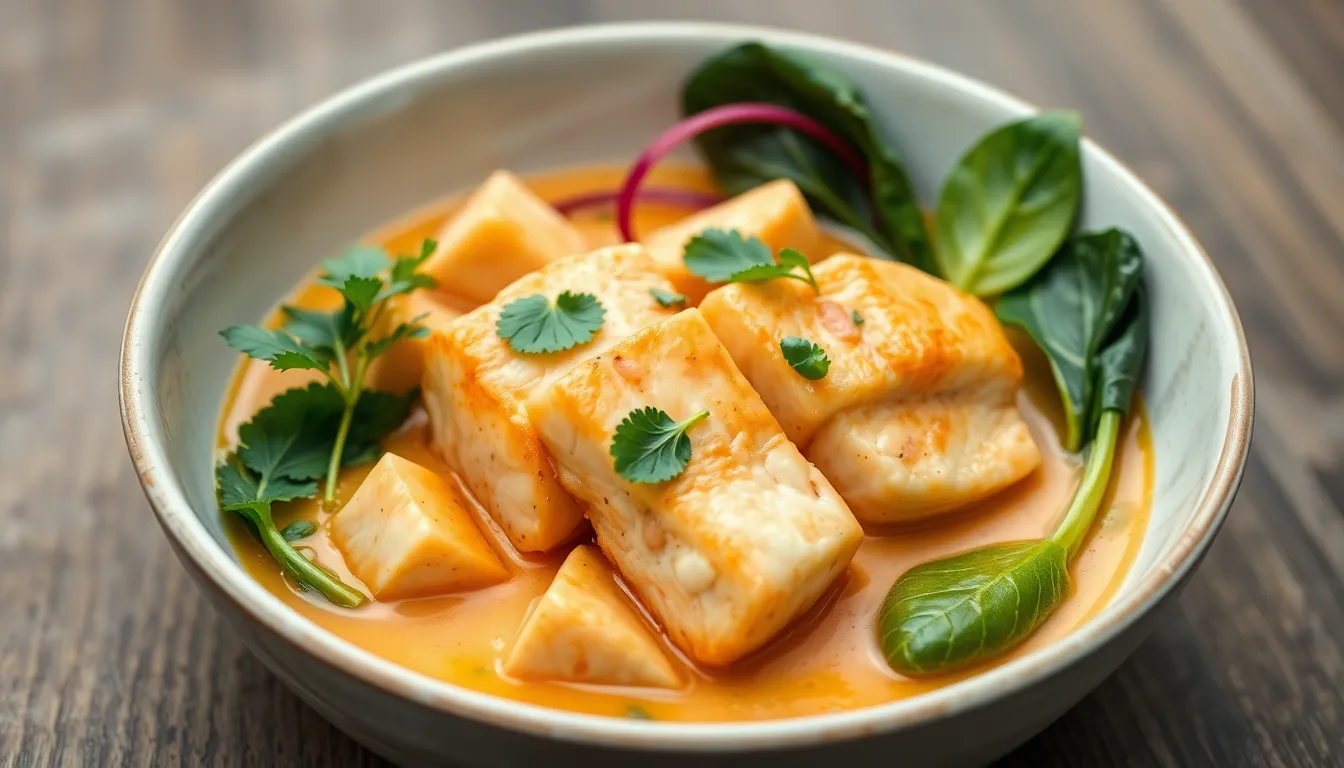
Creating this luxurious curry requires a handful of high-quality ingredients that work harmoniously together. Each component brings its unique characteristics to develop the rich depth of flavor that makes this dish special.
Salmon
For this recipe you’ll need about 1 pound of salmon fillets cut into bite-sized pieces. Select fresh salmon with bright color and firm texture for the best results. The natural richness of salmon pairs perfectly with the creamy curry base while providing heart-healthy omega-3 fatty acids. Salmon remains tender and flaky when gently simmered in the curry sauce allowing it to absorb the surrounding flavors without becoming tough or dry.
Miso Paste
White or brown miso paste serves as the umami powerhouse in this curry creating a savory depth that elevates the entire dish. Add 2-3 tablespoons of miso paste depending on your preference for saltiness and flavor intensity. The paste gets lightly caramelized during the cooking process which enhances its complex flavors. Miso not only contributes its signature umami notes but also provides beneficial probiotics when added toward the end of cooking.
Coconut Milk
Full-fat coconut milk forms the luxurious base of this curry delivering creamy richness that balances the salty miso perfectly. Use one 13.5-ounce can for the ideal consistency and flavor. The natural sweetness of coconut milk complements the fatty nature of salmon while tempering the intensity of the curry spices. This ingredient creates the velvety texture that makes the sauce so irresistible and craveable.
Curry Components
The aromatic foundation begins with sautéed onion garlic and fresh ginger that build essential flavor complexity. Add 2-3 tablespoons of Thai red curry paste for authentic spice and depth. Vegetable or fish stock thins the sauce to your desired consistency while adding another layer of flavor. Fresh lime juice brightens the finished dish cutting through the richness with welcome acidity. Include leafy greens such as bok choy spinach or kale stirred in at the end for color nutrition and textural contrast. Finish with fresh herbs like cilantro and Thai basil that provide aromatic freshness. Optional seasonings including a touch of honey can balance all elements perfectly bringing harmony to this sophisticated yet simple curry.
Tools And Equipment You’ll Need
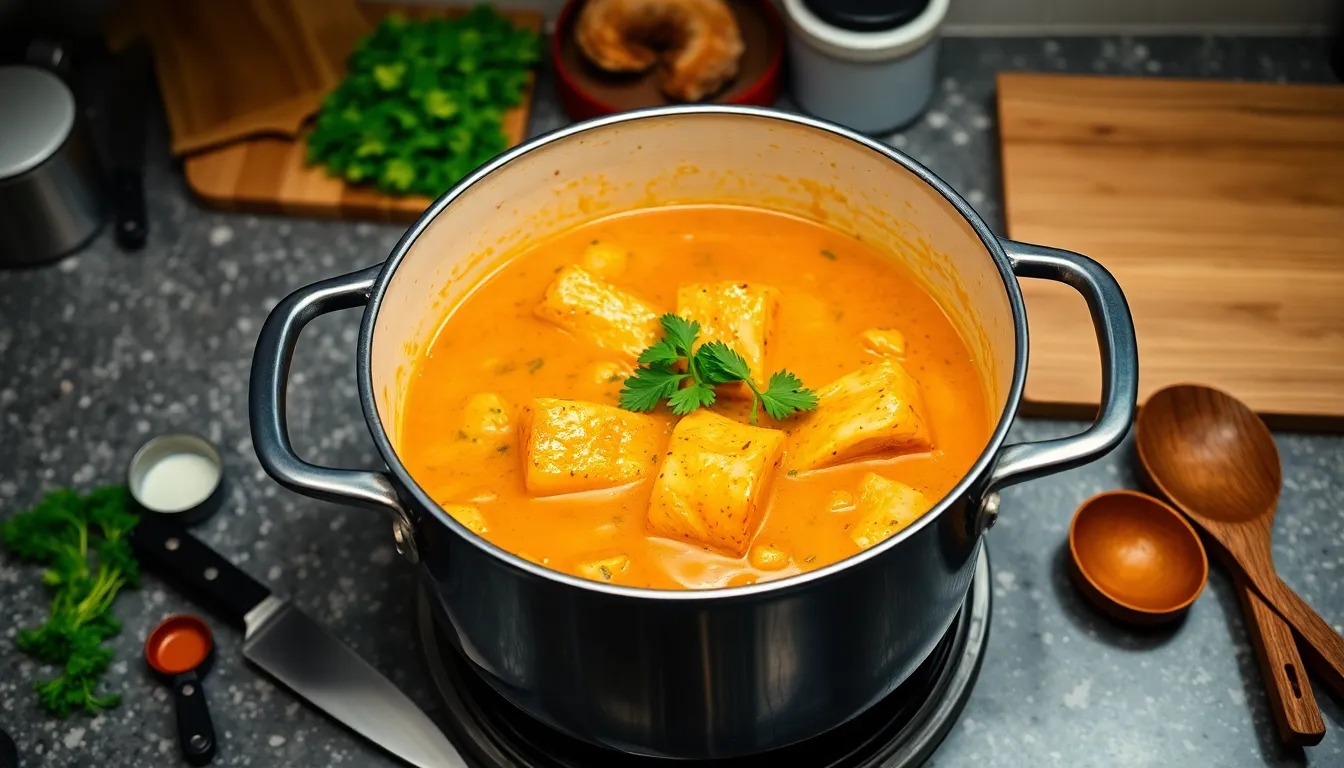
Creating this coconut miso salmon curry requires minimal equipment, making it accessible for cooks of all experience levels. Gather these kitchen essentials before you begin:
- Large pot or deep skillet – A heavy-bottomed vessel with high sides works best for simmering the curry without splashing
- Sharp chef’s knife – For precisely cutting salmon fillets and chopping aromatics
- Cutting board – Preferably with a groove to catch juices when prepping the salmon
- Measuring spoons and cups – For accurate ingredient portioning
- Wooden spoon or heat-resistant spatula – To stir the curry gently without breaking up the salmon pieces
- Microplane or grater – For finely grating fresh ginger
- Citrus juicer – To extract maximum juice from limes
- Serving bowls – Deep bowls work best for this saucy curry
- Small bowl – For mixing the miso paste with a little liquid to ensure it incorporates smoothly
Having everything ready before you begin cooking creates a stress-free experience when preparing this flavorful dish. The beauty of this recipe lies in its simplicity – no specialized equipment needed for restaurant-quality results.
How To Make Coconut Miso Salmon Curry

Transform simple ingredients into an exotic dinner with this step-by-step coconut miso salmon curry recipe. Follow these instructions to create a harmonious blend of creamy coconut milk, savory miso, and tender salmon that’s ready in under 30 minutes.
Preparing The Salmon
- Use fresh salmon fillets with skin removed for the best results
- Cut the salmon into 1 to 2-inch pieces to ensure even cooking and easy serving
- Pat the pieces dry with paper towels to promote better simmering in the curry base
- Set aside while preparing the curry base to preserve the salmon’s delicate texture
Creating The Miso Curry Base
- Heat 2 tablespoons of oil in a large pan or pot over medium heat
- Add finely minced onion, ginger, and garlic; season with salt and pepper
- Sauté the aromatics until softened but not browned (about 3-4 minutes)
- Stir in 1/4 cup white miso paste and cook for approximately 2 minutes, stirring frequently
- Watch as the miso lightly caramelizes, building depth and umami flavor
- Pour in 1/2 cup full-fat unsweetened coconut milk and 1-3 cups water or vegetable stock
- Bring the mixture to a boil over high heat and cook until slightly reduced (about 5 minutes)
Combining The Flavors
- Reduce the heat to medium-low before adding the salmon pieces to the curry base
- Gently place each piece of salmon into the simmering liquid to prevent splashing
- Allow the salmon to cook undisturbed for 4-5 minutes until just cooked through
- The salmon should be opaque on the outside while remaining tender and moist inside
- Add leafy greens like baby spinach or bok choy to introduce color and nutrition
- Squeeze fresh lime juice into the curry to brighten the flavors and balance the richness
Finishing Touches
- Turn off the heat once the salmon is cooked and the greens have wilted
- Stir in a handful of freshly chopped cilantro and basil to add aromatic freshness
- Ladle the curry over a bed of cooked jasmine rice, quinoa, or noodles for a complete meal
- Garnish with additional lime wedges on the side for diners to add extra citrusy acidity
- Serve immediately while hot to enjoy the full spectrum of flavors at their peak
Recipe Variations

The beauty of coconut miso salmon curry lies in its adaptability to different ingredients and flavor preferences. You can easily customize this versatile dish to suit your taste or make use of ingredients you have on hand.
Vegetable Additions
Transform your curry into a complete one-pot meal by incorporating a variety of vegetables. Baby spinach or bok choy make excellent additions when stirred in during the final minutes of cooking, allowing them to wilt gently in the residual heat. Bell peppers add vibrant color and a sweet crunch when sliced and added midway through the simmering process. Sugar snap peas or snow peas contribute texture and freshness without overpowering the delicate flavors of the curry. For heartier variations, add diced carrots or sweet potatoes at the beginning with the aromatics, allowing them to soften and absorb the curry flavors. Fresh mushrooms like shiitake or oyster varieties introduce an earthy dimension that complements the umami of miso beautifully.
Spice Level Adjustments
Customize the heat intensity of your curry to perfectly match your preference. The basic recipe delivers a mild to moderate spice level that focuses more on the aromatic qualities of ginger and garlic rather than heat. Add Thai red curry paste (1-2 tablespoons) during the initial cooking stage with the aromatics for a traditional spicy kick. Fresh chilies, either thinly sliced or minced, can be incorporated with the garlic and ginger for direct heat control. A sprinkle of red pepper flakes offers an easy way to adjust spiciness without altering the fundamental flavor profile. For those preferring a gentler experience, omit any chili elements entirely and rely on the curry’s natural flavors from miso and aromatics. Balance increased spiciness with an extra squeeze of lime or a touch of honey to maintain harmony in the dish’s flavor profile.
Protein Substitutions
While salmon provides the perfect canvas for this curry, several alternatives work wonderfully with the coconut miso base. Firm white fish like cod, halibut, or snapper can replace salmon with minimal recipe adjustments, though they may require slightly less cooking time. Seafood lovers might enjoy substituting shrimp or scallops, which benefit from the quick poaching method and absorb the curry flavors beautifully. For a completely different approach, try firm tofu cut into cubes and gently simmered in the sauce, offering a plant-based alternative with excellent flavor absorption. Chicken thighs, cut into bite-sized pieces, work well for those who prefer poultry, though they require longer cooking time (about 15 minutes) to ensure they’re fully cooked. Each protein brings its unique texture and flavor profile to the dish while still allowing the coconut miso curry base to shine.
What To Serve With Coconut Miso Salmon Curry
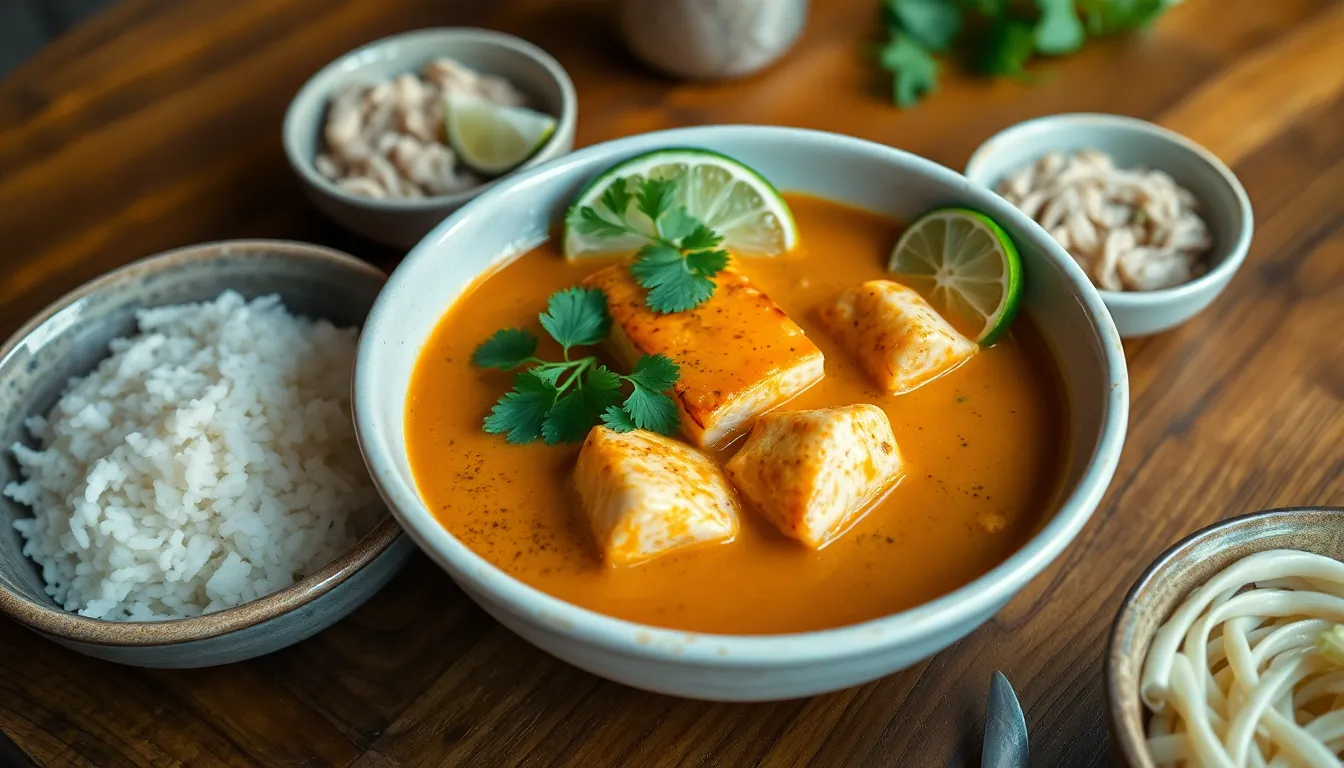
This luxurious coconut miso salmon curry pairs beautifully with several complementary sides that enhance its rich flavors and create a complete dining experience. You can transform this already impressive dish into an unforgettable meal with these perfect accompaniments.
Rice Options
Steamed jasmine or basmati rice serves as the ideal foundation for this curry. The fragrant grains soak up the velvety coconut miso sauce while providing a neutral backdrop that allows the complex curry flavors to shine. For a more nutritious alternative, try serving your curry over quinoa which adds protein and a pleasant nutty flavor that works wonderfully with the umami notes in the dish.
Noodle Alternatives
Rice noodles offer an excellent rice substitute when you want something different. Their delicate texture and mild flavor complement the curry without competing with its rich taste profile. Simply prepare according to package instructions and serve the curry ladled generously over top for an elegant presentation.
Lighter Accompaniments
Cauliflower rice provides a grain-free option that reduces carbohydrates while still offering a satisfying base for absorbing the flavorful sauce. This lighter alternative works particularly well when you want to highlight the richness of the curry without feeling overly full afterward.
Fresh Elements
Fresh herbs bring brightness to this rich dish. Scatter generous amounts of chopped cilantro and basil over your curry just before serving to add aromatic complexity and visual appeal. The herbaceous notes cut through the creamy coconut base and enhance the overall flavor profile.
Acidic Complements
Lime wedges are essential accompaniments to serve alongside your curry. The bright acidity from a fresh squeeze of lime juice balances the richness of the coconut milk and umami depth from the miso paste. This simple addition provides diners the opportunity to adjust the tanginess to their preference.
Vegetable Sides
Leafy greens incorporated directly into the curry add nutritional value and beautiful color contrast. Baby spinach or bok choy wilt perfectly into the warm sauce during the final cooking minutes, providing a tender-crisp texture that complements the soft salmon pieces.
By thoughtfully selecting sides from these options, you create a balanced meal that elevates your coconut miso salmon curry from merely delicious to truly memorable. Each element contributes important flavors and textures that complement the curry’s rich foundation while adding variety to each bite.
Make-Ahead And Storage Tips
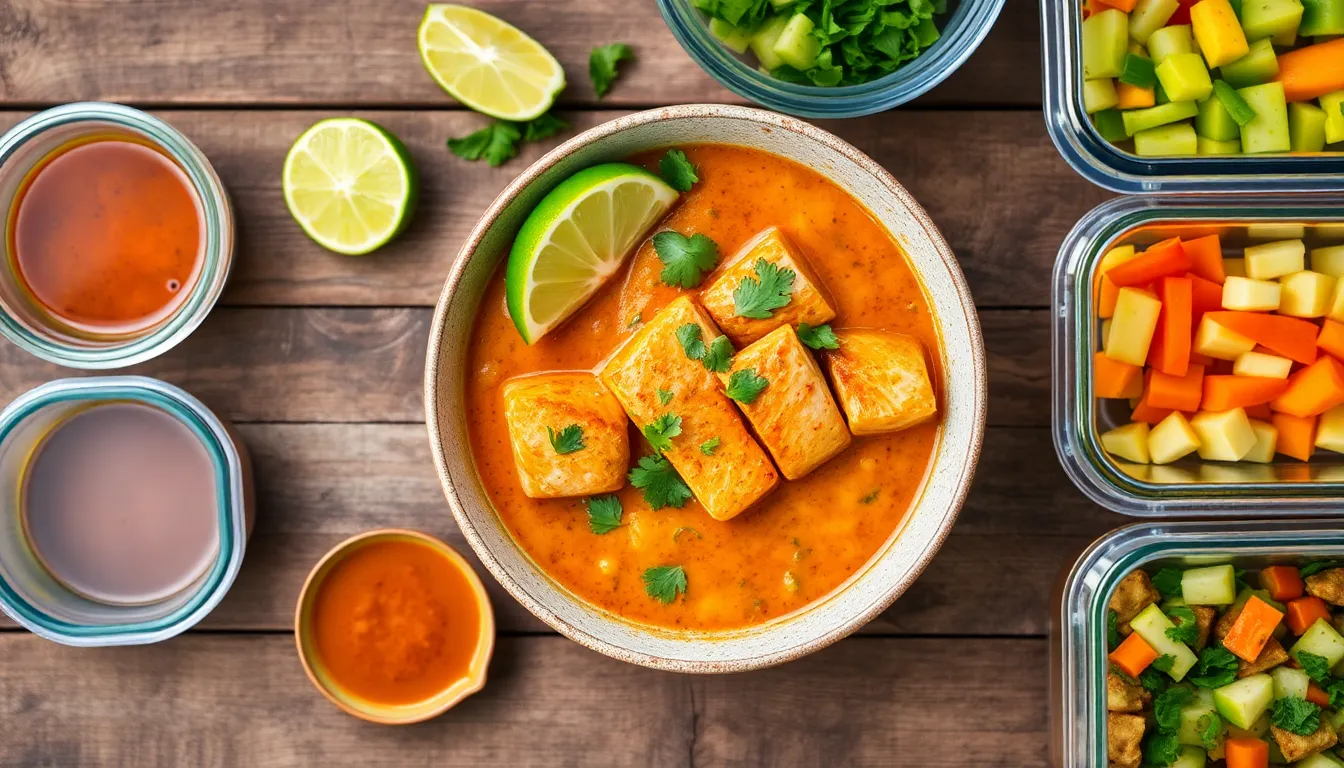
Planning to serve coconut miso salmon curry for a dinner party or looking to streamline your weeknight cooking? This luxurious dish offers several make-ahead options that preserve its delicate flavors and textures.
Prepare Components in Advance
You can easily break down this recipe into components that can be prepared ahead of time:
- The curry base (onions, garlic, ginger, miso, coconut milk, and stock) can be made up to 2 days in advance and refrigerated in an airtight container
- Cut salmon into pieces up to 24 hours before cooking and store covered in the refrigerator
- Wash and chop any vegetables or herbs the day before cooking
- Measure out all your spices and have them ready in small bowls
Final Assembly
When ready to serve, simply:
- Reheat your curry base over medium heat until simmering
- Add the salmon pieces and cook as directed in the main recipe
- Incorporate leafy greens and lime juice just before serving for maximum freshness and vibrant color
This approach maintains the integrity of each component while saving important preparation time when you’re ready to eat.
Refrigeration Guidelines
Proper storage ensures your leftover curry remains safe and delicious:
- Cool the curry completely to room temperature before refrigerating
- Store in an airtight container for 2-3 days maximum
- Keep the curry in the coldest part of your refrigerator (below 40°F/4°C)
- Consider storing the rice or noodles separately to prevent them from absorbing too much liquid
Freezing Recommendations
While the complete curry doesn’t freeze well, you have options:
- Freeze only the curry base (without salmon) for up to 2 months
- Already cooked salmon can be frozen separately for 2-3 months
- Thawed salmon works well repurposed in dishes like salmon patties or salads
- Label containers with the date and contents for easy identification
Reheating Tips
Gentle reheating preserves the delicate texture of the salmon and prevents the sauce from breaking:
- Warm refrigerated curry in a covered pan over low heat
- Add a splash of coconut milk or stock if the sauce has thickened
- Stir occasionally but gently to avoid breaking up the salmon pieces
- Heat only until the curry reaches serving temperature (avoid boiling)
By following these make-ahead and storage guidelines, you can enjoy this coconut miso salmon curry at its best while maximizing convenience and minimizing food waste.
Recipe Card
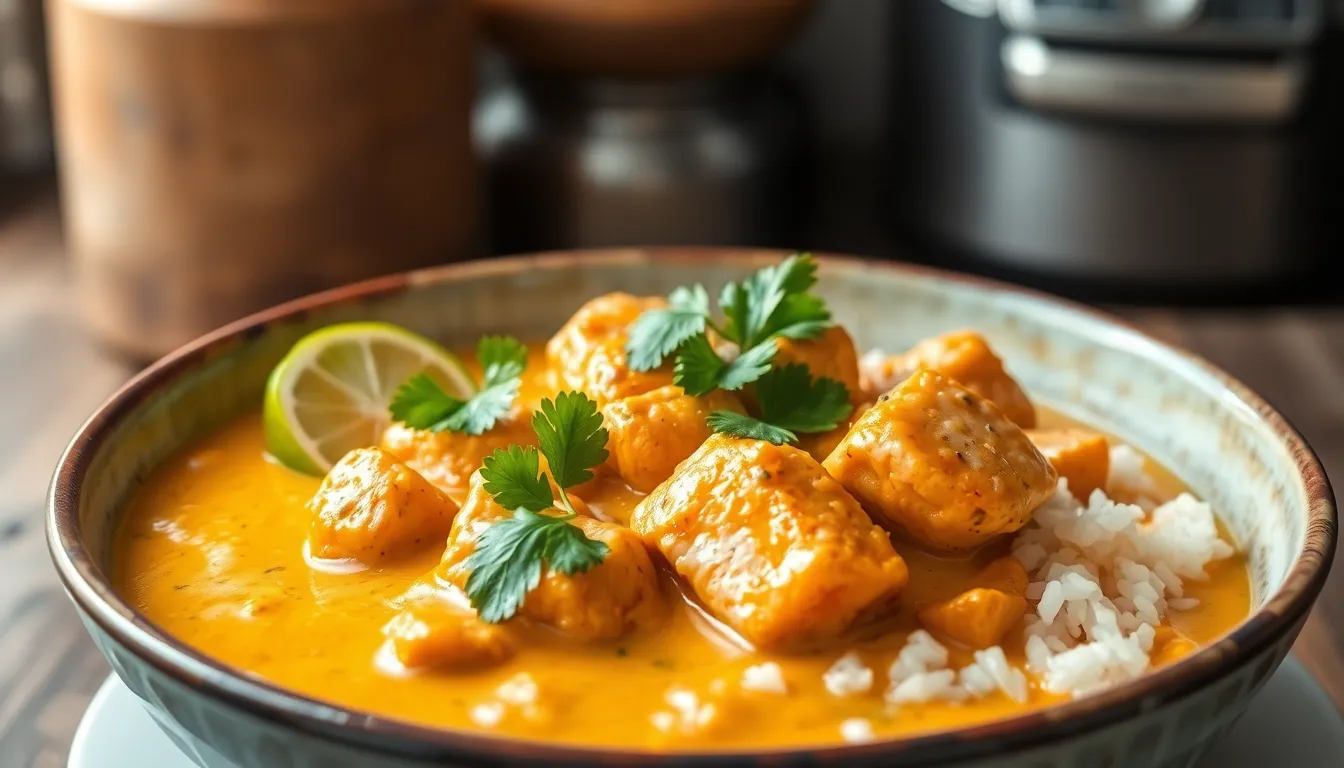
Ingredients
- 1 pound salmon fillets, cut into 1-2 inch chunks
- ¼ cup white or yellow miso paste
- 1 can (14 oz) full-fat coconut milk
- 1 medium onion, thinly sliced
- 3 cloves garlic, minced
- 1 tablespoon fresh ginger, grated
- 2 tablespoons vegetable or canola oil
- 2 tablespoons fresh lime juice
- 2 cups baby spinach or bok choy
- ¼ cup fresh cilantro, chopped
- ¼ cup fresh basil leaves, torn
- ½ cup vegetable or fish stock (or water)
- Salt and black pepper to taste
- Optional: 1-2 teaspoons Thai red curry paste
- Optional: 1 teaspoon honey for balance
Instructions
- Heat oil in a large pan over medium heat and add onions, ginger, and garlic with a pinch of salt and pepper. Cook for 3-7 minutes until softened but not browned.
- Add miso paste to the pan and stir frequently for 2 minutes to slightly caramelize, improving its flavor profile.
- Pour in coconut milk and stock, bringing the mixture to a gentle boil before reducing heat to simmer for 3 minutes until the sauce begins to thicken.
- Add salmon pieces to the pan and simmer on medium-low heat for 4-5 minutes until just cooked through. Avoid overcooking to keep the salmon tender.
- Turn off the heat and stir in baby spinach or bok choy along with fresh lime juice, allowing residual heat to wilt the greens.
- Taste and adjust seasoning if needed with additional salt, pepper, or a touch of honey for balance.
- Serve immediately over steamed jasmine rice or your preferred noodles, garnishing with fresh cilantro, basil, and lime wedges.
Cooking Time
- Prep Time: 10 minutes
- Cook Time: 15 minutes
- Total Time: 25 minutes
- Servings: 4
Nutrition Information
| Nutrient | Amount per Serving |
|---|---|
| Calories | 320 |
| Protein | 25g |
| Fat | 22g |
| Carbohydrates | 8g |
| Fiber | 1g |
| Sodium | 540mg |
Cook’s Notes
For best results, use premium coconut milk for maximum creaminess. This curry remains mild but flavorful, perfect for weeknight dinners. Pat salmon dry before adding to the curry for better texture. Adjust liquid consistency with additional stock if needed. The caramelization of miso adds essential depth of flavor, so don’t skip this step. Fresh lime juice brightens the dish significantly, adding necessary acidity to balance the rich coconut and savory miso components.
Nutritional Information
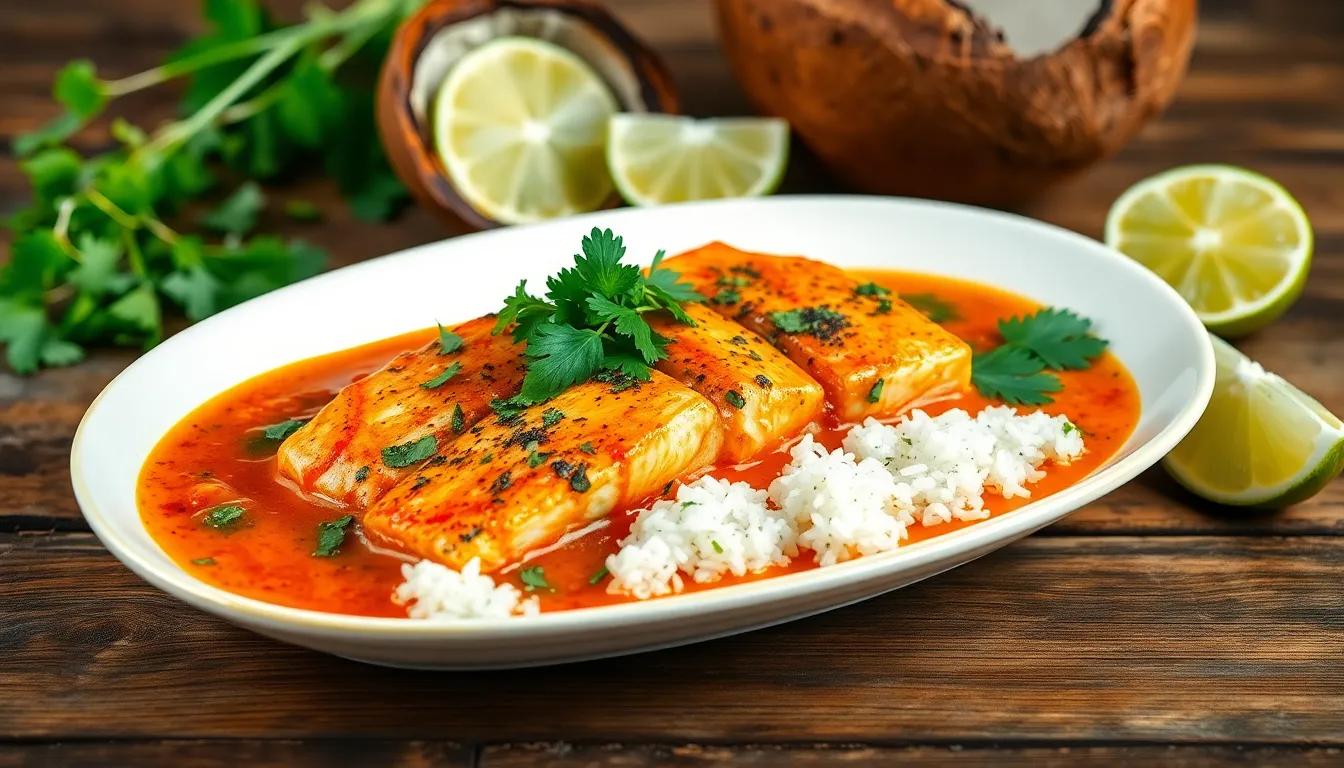
Understanding the nutritional profile of this coconut miso salmon curry helps you make informed dietary choices while enjoying its rich flavors. Each serving of this luxurious dish provides a balanced combination of macronutrients and essential vitamins.
A typical serving contains approximately 415 calories, making it a satisfying main course that won’t overwhelm your daily caloric intake. The macronutrient distribution showcases the dish’s focus on healthy fats and quality protein:
| Nutrient | Amount | Percentage of Total Calories |
|---|---|---|
| Fat | 29g (20g saturated) | 63% |
| Protein | 26g | 25% |
| Carbohydrates | 12g | 11% |
This curry delivers exceptional nutritional benefits beyond basic macronutrients. Salmon stands out as the star ingredient, providing an impressive 82% of your daily vitamin D requirements per serving. You’ll also receive about 47% of your daily protein needs, supporting muscle maintenance and overall satiety.
The mineral content enhances this dish’s nutritional value with 13% of your daily potassium and 10% of your daily iron requirements. Additional minerals include calcium, copper, and choline in smaller but beneficial amounts.
Health-conscious diners will appreciate that the fat content primarily comes from salmon’s omega-3 fatty acids and coconut milk’s medium-chain triglycerides. These fats support heart and brain health while providing sustained energy. Miso contributes beneficial probiotics that support gut health, while fresh herbs and lime juice add antioxidants that combat oxidative stress.
The balanced combination of protein and healthy fats creates a satisfying meal that helps maintain stable blood sugar levels. Adding leafy greens like spinach or bok choy boosts the fiber content and provides additional vitamins and minerals without significantly increasing the calorie count.
The Perfect Coconut Miso Salmon Curry Awaits
This coconut miso salmon curry isn’t just a meal—it’s your new culinary secret weapon. With its perfect balance of creamy coconut milk umami-rich miso and tender salmon you’ve discovered a dish that feels both indulgent and nourishing.
Remember that the beauty of this recipe lies in its flexibility. Make it spicier add different vegetables or swap proteins to suit your taste. The foundations remain the same: a velvety sauce hearty protein and aromatic base that come together in under 30 minutes.
Whether you’re serving it over jasmine rice with fresh herbs or preparing components ahead for busy weeknights this curry delivers restaurant-quality flavor with minimal effort. Your journey to mastering this Asian-inspired dish ends here but your enjoyment of it is just beginning.
Frequently Asked Questions
What makes coconut miso salmon curry unique?
Coconut miso salmon curry uniquely blends Japanese and Southeast Asian flavors, combining creamy coconut milk with umami-rich miso paste. This fusion creates a velvety sauce that complements tender salmon perfectly. Unlike traditional curries that require hours of simmering, this dish delivers complex, restaurant-quality flavor in just 30 minutes, making it both sophisticated and accessible for weeknight cooking.
How long does it take to prepare this curry?
This curry can be prepared in approximately 30 minutes, making it perfect for busy weeknights. The quick cooking time doesn’t compromise flavor, as the thoughtful combination of ingredients creates depth and complexity quickly. The simple preparation involves sautéing aromatics, adding the curry base ingredients, and gently simmering the salmon until just cooked through.
Can I substitute the salmon with other proteins?
Absolutely! While salmon works beautifully with the coconut miso sauce, you can substitute it with firm white fish, shrimp, tofu, or chicken thighs. Each alternative will bring its own unique texture and flavor while still complementing the creamy, umami-rich base. Just adjust cooking times accordingly, as these proteins require different cooking durations.
What type of miso paste works best for this recipe?
Both white (shiro) and brown (aka) miso paste work well in this recipe. White miso offers a milder, sweeter flavor ideal for those new to miso, while brown miso provides a stronger, more pronounced umami character. The miso paste caramelizes slightly during cooking, developing complex depth of flavor that forms the foundation of this curry.
Is this curry spicy?
The basic recipe is mild to moderately spicy, but you can easily adjust the heat level to your preference. For a spicier version, add more Thai red curry paste or fresh chilies. For a milder curry, reduce or omit the curry paste and rely on the aromatics and miso for flavor. The recipe’s flexibility makes it suitable for all spice tolerance levels.
What should I serve with coconut miso salmon curry?
This curry pairs beautifully with steamed jasmine or basmati rice, which soaks up the flavorful sauce. Other excellent options include rice noodles, quinoa, or cauliflower rice for a lower-carb alternative. Fresh herbs like cilantro and Thai basil add brightness, while lime wedges provide acidity that balances the rich flavors of the dish.
Can I make this curry ahead of time?
Yes, you can prepare components ahead of time to streamline cooking. The curry base (without salmon) can be made up to 2 days in advance and refrigerated. For best results, add the salmon just before serving to prevent overcooking. Alternatively, complete curry can be refrigerated for up to 2 days and gently reheated, though the salmon texture may change slightly.
Is coconut miso salmon curry healthy?
This curry offers excellent nutritional benefits. Each serving provides approximately 415 calories with a good balance of protein from salmon (rich in omega-3 fatty acids and vitamin D) and healthy fats from coconut milk. Miso adds beneficial probiotics, while added vegetables increase fiber and nutrients. The dish supports heart and brain health while providing a satisfying, nutrient-dense meal.
